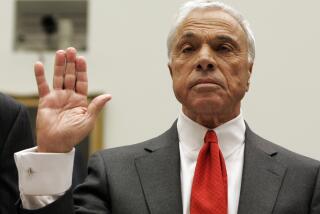Washington Mutual created ‘mortgage time bomb,’ Senate panel says
- Share via
Reporting from Los Angeles and Washington — Before Washington Mutual collapsed in the largest bank failure in U.S. history, its executives knowingly created a “mortgage time bomb” by making subprime loans they knew were likely to go bad and then packaging them into risky securities, a congressional investigation has found.
In some cases, the bank took loans in which it had discovered fraudulent activity -- such as misstated income by borrowers -- and rolled them into mortgage securities sold to investors without disclosing the fraud, according to the report released Monday by the Senate’s Permanent Subcommittee on Investigations.
The actions were driven in part by greed, according to the committee report, which pointed out that WaMu’s pay practices rewarded loan officers and processors based on how many mortgages they could churn out.
The new disclosures could give a boost to efforts by President Obama and congressional Democrats to pass sweeping overhaul of financial regulations, which the Senate is set to consider this spring, said Sen. Carl Levin (D-Mich.), the subcommittee’s chairman.
“Washington Mutual built a conveyor belt that dumped toxic mortgage assets into the financial system like a polluter dumping poison into a river,” Levin said. “Using a toxic mix of high-risk lending, lax controls and destructive compensation policies, Washington Mutual flooded the market with shoddy loans and securities that went bad. . . . It is critical to acknowledge that the financial crisis was not a natural disaster, it was a man-made economic assault.”
WaMu’s failure is also under investigation by the Justice Department. The Seattle-based thrift, which was seized by federal regulators in September 2008 and sold to JPMorgan Chase & Co. for $1.9 billion, had nearly a third of its 2,200 branches in California and was a major player, along with rival Countrywide Financial Corp., in helping fuel the state’s housing boom.
According to the Senate report, WaMu executives were aware in 2006 of problems at its Southern California subprime unit, Long Beach Mortgage Co. Excerpts of internal e-mails and reports offer a stark and unvarnished view of the warning signs that were dismissed as the bank tumbled toward failure.
The company’s chief risk officers called Long Beach Mortgage, the subprime subsidiary the firm used to stage its rapid growth in home lending, “a real problem for WaMu.” Stephen Rotella, WaMu’s former chief operating officer, described the unit as “terrible.”
“Short story is this is not good,” David Schneider, WaMu’s former president of home loans, wrote in a December 2006 e-mail. “We are all rapidly losing credibility as a management team.”
Long Beach Mortgage was founded by the late Roland E. Arnall, a West Los Angeles billionaire who later built Ameriquest Mortgage Co. and its sister companies into the nation’s largest subprime operation.
Washington Mutual acquired the bulk of Long Beach Mortgage -- the part that offered loans through brokers, not through its own employees -- in 1999.
Long Beach Mortgage’s lending reflected the general disintegration of standards across the industry, said Paul Muolo, executive editor of National Mortgage News and co-author of “Chain of Blame,” a 2008 book about the mortgage meltdown. Companies such as Orange-based Ameriquest, Irvine’s New Century Financial Corp. and San Jose’s First Franklin Financial Corp. competed for ever riskier subprime loans that Wall Street banks transformed into mortgage bonds and sold around the world.
“It’s hard to say which lender went berserk first,” Muolo said, as the subprime rivals wound up adopting the philosophy “If he or she breathes, we will make the loan.”
The subcommittee’s investigators, who conducted more than 100 interviews and depositions and collected 50 million documents, found that Washington Mutual jumped headlong into subprime and other risky lending in 2003 to increase profits.
The company and its Long Beach unit “used shoddy lending practices . . . to make tens of thousands of high-risk home loans that too often contained excessive risk, fraudulent information or errors,” according to a subcommittee memo.
Internal company documents highlighted the profit pressures. “In 2007, we must find new ways to grow our revenue. Home Loans Risk Management has an important role to play in that effort,” read a late 2006 message from the unit’s chief risk officer to the risk management team.
Adding to the problems, WaMu and Long Beach Mortgage frequently steered borrowers who qualified for prime loans into subprime loans, the subcommittee found. WaMu then spread the risk of those loans and riskier ones to investors by packaging the subprime loans into $77 billion worth of securities it sold to investors, the panel found.
“At times, WaMu selected and securitized loans that it had identified as likely to go delinquent,” the report said.
A June 2008 review by the bank’s main regulator, the Office of Thrift Supervision, found a “culture focused more heavily on production volume rather than quality.”
Top employees could become members of the company’s President’s Club, which offered lavish, all-expense-paid trips to Hawaii or the Caribbean, the subcommittee found.
Levin said the findings showed the need for a new consumer financial protection agency, which Obama has proposed as part of his regulatory overhaul, to stop lenders from preying on borrowers. “The bottom line is that WaMu had poor policies, poor controls, inadequate oversight of its loans [and] turned out toxic mortgages that sunk the bank, devastated homeowners and polluted the financial system like a poison,” Levin said. “This was a Main Street bank that got taken in by these Wall Street profits.”
JPMorgan, which acquired WaMu, had no comment on the report.
On Tuesday, the Senate subcommittee launches a series of hearings looking at WaMu’s 2008 failure as a case study of the financial crisis. Former WaMu executives are scheduled to testify Tuesday, with testimony Friday from regulators and later this month from credit rating firms and investment banks that also contributed to the bank’s problems.
A report to be released Friday from the inspectors general of two agencies that regulated WaMu -- the Office of Thrift Supervision and the Federal Deposit Insurance Corp. -- is expected to fault the regulators for their oversight of the bank.
jim.puzzanghera@
latimes.com
More to Read
Inside the business of entertainment
The Wide Shot brings you news, analysis and insights on everything from streaming wars to production — and what it all means for the future.
You may occasionally receive promotional content from the Los Angeles Times.












